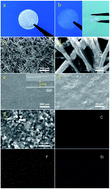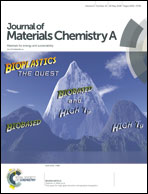Nano-SiO2-embedded poly(propylene carbonate)-based composite gel polymer electrolyte for lithium–sulfur batteries†
Abstract
All-solid-state electrochemical energy storage devices are highly in demand for future energy storage, where quasi-solid-state systems, such as gel polymer electrolytes, represent an important step towards this goal. Herein, a novel poly(propylene carbonate)-based composite gel polymer electrolyte (G-PPC-CPE) with 7.3 wt% ether-based electrolyte as a plasticizer was developed for a (sulfur/polyacrylonitrile)/lithium (S/PAN)/Li cell. The embedded SiO2 nanoparticles acted as multifunctional fillers, and could improve the interfacial stability and enhance the ionic conductivity and lithium ions transference number, as well as cooperate with the PPC polymer matrix to suppress the diffusion of LiPSs. Compared to the common carbonate-based electrolyte, (S/PAN)/Li with the G-PPC-CPE could deliver a higher sulfur utilization (∼100%), a high reversible capacity of 700.5 mA h gcomposite−1 (1668 mA h gsulfur−1) over 100 cycles and a long cycle life with 85% capacity retention after 500 cycles. Moreover, an inhibited self-discharge behaviour and a decent rate performance could be obtained simultaneously. XPS analysis was used to further elucidate the interaction mechanism of the nano-SiO2. The blocking effect of G-PPC-CPE for LiPSs was confirmed by XPS analysis of S 2p on the lithium anode. In brief, G-PPC-CPE guarantees good prospects for the development of quasi-solid-state LSBs with high performance at ambient temperature.



 Please wait while we load your content...
Please wait while we load your content...